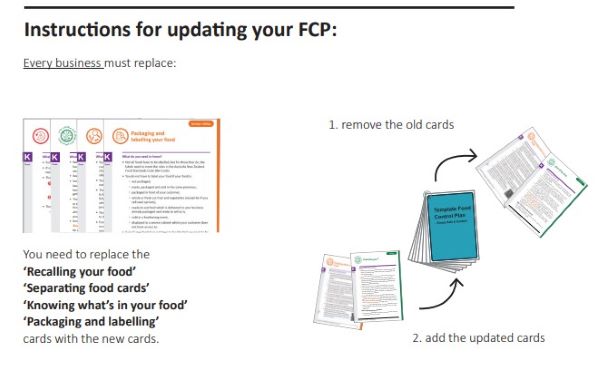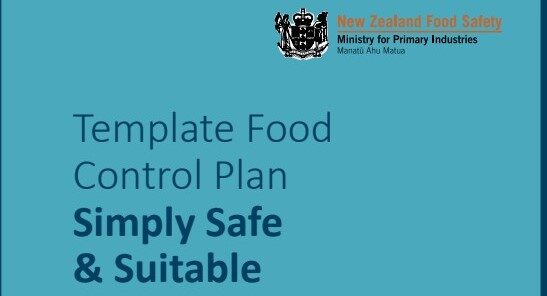MPI have updated the template Food Control Plan, Simply Safe and Suitable to version 4. There are 8 topics that are significantly different, and some minor wording changes on other pages. So if you have an FCP you’ll need to take action now. If you are on a National Programme or My Food Plan they haven’t changed just yet, but the new Mock Recall requirements will still kick in for you on 1 July 2023 so keep reading…
Deadline for making changes
If you have a Simply Safe and Suitable Food Control Plan you need to update the 8 topics by 30 June 2023, and the rest by 20 February 2024. Or you can update the whole version now.
What’s changed?
There are 8 topics with significant changes, 4 which will apply to most people and 4 of the more specialist pages that you only need if you do those activities:
- Recalling your food
- Separating food
- Knowing what’s in your food
- Packaging and Labelling
- Making sushi
- Hot smoking to control bugs
- Managing self-supply water
- Using acid to control bugs
How do I get the new pages or new plan?
You can visit the MPI website and download the 8 individual topic updates from the link at the end of this article.
Or to make life easier I’ve put the 8 significant ones into a pdf you can download for free.
You can also ask the Council you are registered with for some physical copies and see if they have a supply.
Hopefully the Council have already contacted you about these changes to let you know, so this might just be a reminder or extra information.
What’s different in the new topics?
The 8 significantly different ones have the updated legal changes mainly to do with mock recalls and the plain English allergen labelling requirements. Here’s a mini-summary of the changes:
Recalling your food – from 1 July 2023 it will be a requirement for every business to do a mock recall once a year. This involves thinking of a scenario, for example a supplier recalls an ingredient, and then working through the steps to practice what you would do. Read more detail in my other article here. This new requirement applies to businesses on a National Programme and My Food Plan too, from 1 July, so please have a read. I expect the NP guidance and My Food Plan to get updated soon.
Separating food and Knowing what’s in your food and Packaging and labelling – these reflect the legal changes in how to label allergens. Changes include from using the generic term ‘tree nuts’ to using the prescribed name of the actual nuts, and the inclusion of wheat separately from gluten as an allergen, and using the word milk not dairy. These changes are part of the Plain English Allergen Labelling (PEAL) regulations. Read more on my previous article here and download the MPI allergen labelling guide to make sure you update your labels and menu information accurately.
Making sushi – the pH of sushi rice now needs to be between pH3.0 and 4.3, previously it was 2.4 to 4.6. You can only use a calibrated pH meter now for measuring the pH, as strips or paper cannot give accurate enough results. The time and temperature requirements stay the same, but there is more information on cooling the sushi rice safely.
Using acid to control bugs – this page has been split out from the previous version that covered using acid, water activity and hot smoking, so each topic has its own page now making it easier to understand. The new Using acid page has two levels, pH3.0 to 3.6 for most products, or less than 4.6 for pickled products. It includes fermenting foods to cause acidity aswell as acidifying with vinegar or pickling solutions.
Hot smoking to control bugs – this page is also now separated from the previous combined processes page. There are new time and temperature combinations for hot smoking seafood and fish. Meat still has to be hot smoked to 75 degrees for 30 seconds or an equivalent from the cooking poultry card. If you only hot smoke for flavour the pages clarify that you must follow the 2hr/4hr rule and cool food correctly.
Managing self-supply water – this page has been updated to clarify that you will need a treatment system for self-supplied water from roof, surface or ground water. The testing requirement applies to new supplies and if something changes that could affect your water eg a flood or earthquake. You don’t need to do annual testing now, but do need to show your maintenance records of your treatment system.

Other changes in the full FCP
Some of the other changes in the FCP could make record keeping a bit simpler. You can now prove your cooling method 3 times and just record it once a week, similar to the proving cooking methods. There is also additional information for people selling live shellfish or importing food. There are new Record Blanks too which you can download from links below.
Summary
The main changes to the FCP reflect the new rules around recalls and plain English allergen labelling. These will apply to National Programme and My Food Plan businesses too so I expect those will be updated soon. The acidity requirements are the other main change for fermenting, pickling and making sushi. Anyone on a FCP I’d recommend updating the whole new version now so that its done and you don’t have to worry about it over the busy January and February time.
Links
8 main updated pages Downloadable pdf here
Full new version 4 of the FCP from MPI website here
New versions of Record Blanks from MPI website here
MPI website with update instructions and links to separate pages here

